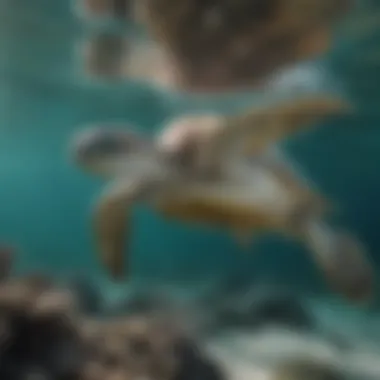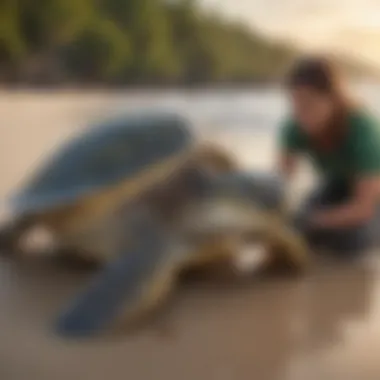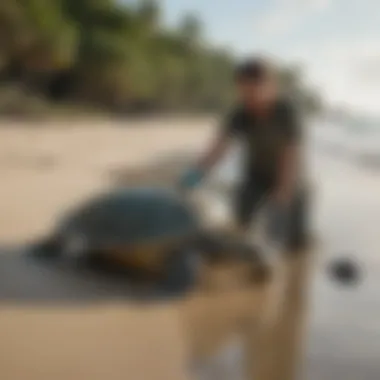Unraveling the Endangered Status of Green Sea Turtles: An In-Depth Analysis


Overview of the Topic
Green sea turtles are a species of marine reptiles facing a perilous threat to their existence, marking a crucial environmental issue that demands urgent attention. These graceful creatures play a vital role in maintaining the balance of marine ecosystems, making their preservation essential.
Current Status and Challenges
Currently, green sea turtles are teetering on the brink of endangerment due to a multitude of factors. Human activities such as habitat destruction, pollution, and overexploitation have significantly contributed to their dwindling population. Climate change further exacerbates their plight, leading to adverse effects on their nesting grounds and food sources.
Sustainable Solutions
In light of the challenges faced by green sea turtles, implementing sustainable practices is paramount to secure their survival. Initiatives focusing on habitat protection, reducing plastic pollution, and establishing marine protected areas have shown promising results in conservation efforts. Successful case studies demonstrate that proactive resource management can lead to positive outcomes in safeguarding these magnificent creatures.
Impact and Importance
The declining population of green sea turtles not only poses a threat to marine biodiversity but also impacts the livelihoods of coastal communities reliant on healthy marine ecosystems. Conservation efforts are crucial not only for the current generations but also to ensure a sustainable future for coming generations. Emphasizing the importance of preserving these majestic marine creatures underscores the urgent need for collective action to safeguard our natural heritage.
Introduction
Green sea turtles, emblems of the marine world, face a perilous trajectory towards endangerment. As marine reptiles with a pivotal role in oceanic ecosystems, their dwindling numbers raise crucial concerns. The menace posed by human activities, coupled with climate change repercussions, accentuates this species' vulnerable status. This article offers an in-depth exploration of the endangered status of green sea turtles, providing insights into the detrimental factors accelerating their decline and the conservation initiatives in place.
Overview of Green Sea Turtles
Green sea turtles, marked by specific features setting them apart in the marine realm, possess traits vital to their survival. The discussion on the distinctive characteristics of green sea turtles showcases their unique biological attributes that influence their resilience amidst evolving environmental challenges. From intricate habitat preferences to navigational marvels in migration patterns, green sea turtles navigate oceans with prowess. The critical importance of green sea turtles in maintaining ecological balance manifests in their foraging habits, propagation contributions, and symbiotic relationships within marine ecosystems.
The Distinctive Characteristics
The package of distinctive characteristics that green sea turtles boast includes captivating physical traits and behavioral adaptations. Their streamlined shells, flipper design, and reproductive strategies underpin their survival tactics. These features not only aid in their defense but also optimize their efficiency in essential activities, making them exquisite subjects for marine enthusiasts.
Habitat and Migration Patterns
The ubiquitous presence of green sea turtles across tropical and subtropical waters underscores their adaptability. Their migration journeys span vast distances, illustrating their remarkable navigational instincts and connectivity to diverse oceanic habitats. Understanding their preferred environments and migratory routes unveils the intricacies of their survival strategy in a constantly changing marine landscape.
Importance in Ecosystem


Anchored in oceanic food webs, green sea turtles hold a pivotal position in the delicate balance of marine ecosystems. Their herbivorous diet shapes seagrass communities, mitigating algal proliferation and promoting biodiversity. By examining their ecological role, one appreciates the cascading effects of their presence or absence, highlighting the significance of safeguarding these gentle giants.
Significance of Green Sea Turtles
Exploring the multifaceted value of green sea turtles reveals the intertwined relationship between humans and these enigmatic creatures. The ecological, economic, and cultural importance of green sea turtles transcends individual interests, emphasizing their broader impact on society and their intrinsic worth in the natural world.
Ecological Importance
The ecological significance of green sea turtles extends beyond their immediate surroundings, influencing marine habitats on a global scale. Their grazing behaviors on seagrass meadows maintain ecosystem resilience, promoting the health of coastal environments and supporting various marine species. The emblematic role they play as indicators of ecosystem health underscores the importance of preserving their populations.
Economic Value
Beyond their ecological contributions, green sea turtles hold economic value for coastal communities engaged in marine tourism and research. Their charismatic appeal attracts tourists seeking immersive wildlife encounters, generating revenue for local economies. The economic benefits of conserving green sea turtle habitats are evident, reflecting the interconnectedness of environmental and economic prosperity.
Cultural Significance
Embedded in cultural narratives and traditions, green sea turtles symbolize resilience, wisdom, and interconnectedness in diverse societies. Their depictions in indigenous folklore, art, and spiritual practices underscore their cultural significance as revered marine beings. The preservation of green sea turtles transcends biological conservation, resonating deeply with human traditions and values, fostering a harmonious relationship between people and the natural world.
Endangered Status of Green Sea Turtles
The section focusing on the endangered status of Green Sea Turtles in this article serves as a pivotal element in understanding the critical state these majestic marine creatures face. Highlighting the key points that will be discussed in detail, such as the crucial factors contributing to their decline and the conservation efforts in place, this section delves deep into the intricate balance between human activities and the preservation of Green Sea Turtles. It offers a comprehensive overview of the challenges these turtles encounter and the urgent need for conservation measures to ensure their survival and ecological significance.
Decline in Population
Impact of Human Activities
Unpacking the severity of the impact of human activities on Green Sea Turtles reveals a stark reality in the face of habitat destruction, pollution, and direct exploitation. The key characteristic of the impact lies in the irreversible harm caused by human intervention, leading to a rapid decline in population numbers. Despite being a detrimental choice for the article's goal of highlighting conservation issues, this aspect sheds light on the urgency of addressing human-induced threats, showcasing the detrimental effects of unsustainable practices on these vulnerable creatures, emphasizing the need for immediate action to mitigate further damage.
Climate Change Effects
Exploring the ramifications of climate change on Green Sea Turtles underscores the challenges posed by rising sea temperatures, ocean acidification, and extreme weather events. This critical aspect serves as a poignant reminder of the compounding pressures faced by these creatures in their natural habitats. While being a distressing choice for the article, it illuminates the interconnectedness between global environmental changes and the vulnerabilities of Green Sea Turtles, emphasizing the importance of implementing adaptive strategies to safeguard their survival in a changing climate.
Predation and Disease


Delving into the threats posed by predation and disease unveils yet another layer of challenges faced by Green Sea Turtles in sustaining viable populations. The key characteristic of this aspect lies in the complex interactions between natural predators, pathogens, and the turtles themselves, leading to increased mortality rates and compromised reproductive success. Despite presenting disadvantages in the context of the article, it underscores the intricate ecological dynamics shaping the survival prospects of Green Sea Turtles, urging conservationists to address these threats through targeted research, monitoring, and intervention measures.
Current Conservation Status
Listing as Endangered Species
Examining the designation of Green Sea Turtles as endangered species underscores the dire need for heightened protection measures and conservation efforts. The key characteristic of this aspect lies in the acknowledgement of the turtles' vulnerable status and the legal frameworks in place to safeguard their well-being. While being a somber reflection of the species' declining numbers, it underscores the imperative of international collaboration and coordinated conservation strategies to prevent further declines in population levels, emphasizing the importance of regulatory mechanisms in promoting sustainable coexistence between humans and these iconic marine species.
International Protection Measures
Navigating the realm of international protection measures unveils a spectrum of initiatives aimed at safeguarding Green Sea Turtles across their global range. The key characteristic of this aspect lies in the collaborative efforts among nations to establish conservation agreements, marine protected areas, and monitoring programs to ensure the long-term survival of these endangered species. Despite presenting challenges in implementation and enforcement, these measures signify a collective commitment to preserving biodiversity and ecosystem health, showcasing the potential for international cooperation to mitigate the threats faced by Green Sea Turtles and other vulnerable marine species.
Conservation Programs
Exploring the diverse array of conservation programs dedicated to Green Sea Turtles offers insights into the multifaceted approaches adopted to secure their habitats and promote sustainable interactions with human communities. The key characteristic of these programs lies in their community-driven nature, involving local stakeholders, researchers, and conservationists in on-the-ground efforts to protect nesting sites, reduce human impact, and raise awareness about the importance of conserving these marine giants. Despite encountering logistical challenges and funding constraints, these programs exemplify the power of grassroots initiatives in effecting positive change and fostering a culture of conservation stewardship, underscoring the transformative potential of localized actions in safeguarding the future of Green Sea Turtles.
Challenges and Threats
In discussing the challenges and threats facing green sea turtles, it is imperative to comprehend the gravity of these issues in ensuring the survival of this species. The section on challenges and threats within the context of the article serves a crucial role in shedding light on the various obstacles that green sea turtles encounter in their natural habitat. By addressing these specific elements, such as poaching and illegal trade, marine pollution, and loss of habitat, we can better understand the complexities of conserving and protecting this endangered species for future generations.
Human-Induced Threats
- Poaching and Illegal Trade: The insidious practice of poaching and illegal trade poses a significant threat to the existence of green sea turtles. This activity involves the unlawful capture and trade of these marine creatures, driven by the demand for their eggs, meat, and shells. The illicit nature of poaching makes it a challenging issue to address effectively, contributing to the dwindling population of green sea turtles. Despite legal protections in place, the lucrative nature of this trade continues to incentivize poachers, fueling the illegal exploitation of these majestic animals.
- Marine Pollution: Another critical human-induced threat facing green sea turtles is marine pollution. This pervasive issue involves the contamination of oceans and seas with various pollutants, including plastics, chemicals, and debris. The accumulation of marine debris poses serious risks to marine life, including green sea turtles, which often mistake plastic waste for food. The ingestion of plastic can have detrimental effects on the health and survival of these turtles, highlighting the urgent need for sustainable waste management practices and pollution mitigation efforts.
- Loss of Habitat: The loss of habitat due to coastal development, climate change, and human activities further compounds the challenges faced by green sea turtles. As coastal areas undergo rapid urbanization and infrastructure expansion, the nesting sites and foraging grounds of these turtles are increasingly threatened. The destruction of critical habitats disrupts the natural behavior and migratory patterns of green sea turtles, pushing them closer to the brink of extinction. Conservation efforts must focus on preserving and restoring these vital habitats to ensure the long-term survival of this endangered species.
Conservation Efforts
When delving into the intricacies of green sea turtle conservation efforts, it is essential to understand the critical role they play in safeguarding the species' survival. Conservation efforts encompass a wide array of activities aimed at mitigating the threats faced by green sea turtles and ensuring their long-term viability. These initiatives involve collaborative work between governments, non-profit organizations, researchers, and local communities, emphasizing the significance of collective action in preserving these marine creatures. By highlighting the importance of conservation efforts, we shed light on the tireless dedication required to protect the endangered green sea turtle population.
Global Initiatives
Convention on Migratory Species
The Convention on Migratory Species stands out as a pivotal international agreement dedicated to the conservation of migratory species, including green sea turtles. This convention facilitates cross-border collaboration in implementing conservation measures, advocating for the protection of vital habitats, migration routes, and nesting grounds for these marine species. The unique feature of the Convention on Migratory Species lies in its ability to engage diverse stakeholders in a unified effort to address transboundary conservation challenges. While advantageous in fostering global cooperation, potential drawbacks may arise from the complexities of aligning varying national interests and priorities within the framework of this convention.


Marine Protected Areas
Marine Protected Areas (MPAs) serve as designated zones aimed at conserving marine biodiversity, including critical habitats for green sea turtles. These areas offer refuge for marine species by restricting human activities that could harm the ecosystem, such as fishing and coastal development. The key characteristic of MPAs lies in their ability to provide sanctuary for endangered species, promoting biodiversity conservation on a local and global scale. While MPAs are instrumental in preserving marine ecosystems, challenges may emerge concerning enforcement, funding, and stakeholder cooperation within these protected zones.
Community-Based Conservation Projects
Community-Based Conservation Projects involve local communities in the conservation of green sea turtles, fostering a sense of stewardship and ownership over the protection efforts. These projects empower residents living in proximity to turtle nesting sites to participate actively in safeguarding these vulnerable species. The key characteristic of community-based projects is their ability to integrate traditional knowledge and practices with modern conservation techniques, creating a harmonious coexistence between humans and turtles. Although beneficial in promoting grassroots conservation action, these projects may face constraints related to long-term sustainability, resource availability, and community engagement levels.
Future Outlook and Recommendations
Establishing sustainable practices is imperative in ensuring the long-term survival of green sea turtles. By focusing on sustainable practices, we can minimize adverse impacts on their habitats and populations. These practices not only benefit the marine ecosystem but also contribute to a more environmentally conscious society. Recommendations for the future include implementing stringent measures to reduce plastic pollution, promoting eco-friendly tourism, and enhancing research and monitoring efforts.
Sustainable Practices
Reducing Plastic Pollution
Reducing plastic pollution is a crucial aspect of preserving the marine environment for green sea turtles. This practice involves minimizing the use of single-use plastics, promoting recycling, and advocating for cleaner oceans. By reducing plastic pollution, we can safeguard the well-being of marine life and mitigate the risks posed by plastic ingestion and entanglement. Although challenging, the benefits of reducing plastic pollution are immense, leading to healthier oceans and thriving ecosystems.
Promoting Eco-Friendly Tourism
Promoting eco-friendly tourism entails encouraging responsible travel practices that minimize environmental impact. By supporting sustainable accommodations, providing educational initiatives, and promoting eco-conscious activities, we can ensure that tourism benefits both communities and the environment. This approach not only preserves natural habitats but also raises awareness about the importance of conservation. While there may be initial challenges, the long-term advantages of promoting eco-friendly tourism are significant, fostering a more sustainable approach to travel.
Enhancing Research and Monitoring
Enhancing research and monitoring efforts is essential for gaining valuable insights into the behaviors and conservation needs of green sea turtles. By conducting in-depth studies, tracking migration patterns, and monitoring nesting sites, researchers can better understand the factors influencing turtle populations. This data-driven approach enables conservationists to make informed decisions and implement targeted measures to protect these endangered species effectively. While resource-intensive, the advantages of enhanced research and monitoring are undeniable, providing a foundation for evidence-based conservation strategies.
Policy Implications
Enforcement of Wildlife Protection Laws
Enforcement of wildlife protection laws is crucial for combatting illegal activities that threaten the survival of green sea turtles. Strengthening regulations, increasing surveillance, and imposing stricter penalties deter poaching and trafficking of turtle products. By enforcing these laws, authorities can uphold conservation efforts and safeguard vulnerable species from exploitation. Although enforcement may pose challenges, the benefits of protecting wildlife through legal means are paramount, ensuring a sustainable future for green sea turtles.
Incorporating Conservation into Policies
Incorporating conservation into policies involves integrating environmental considerations into decision-making processes at all levels. By incorporating conservation principles into legislation, planning, and governance frameworks, policymakers can prioritize the protection of biodiversity and natural resources. This holistic approach promotes sustainable practices, biodiversity conservation, and ecosystem resilience. Despite potential resistance, the advantages of embedding conservation into policies are far-reaching, shaping a more sustainable future for both wildlife and communities.
International Cooperation for Conservation
International cooperation for conservation facilitates collaborative efforts among nations to address transboundary conservation challenges. By exchanging knowledge, resources, and best practices, countries can enhance conservation outcomes and protect shared species like green sea turtles. This collaboration promotes global solidarity in conservation endeavors, fostering mutual understanding and support. While coordination may present logistical hurdles, the benefits of international cooperation for conservation are profound, leading to more effective conservation strategies and positive outcomes for biodiversity preservation.



